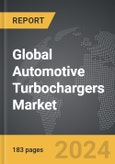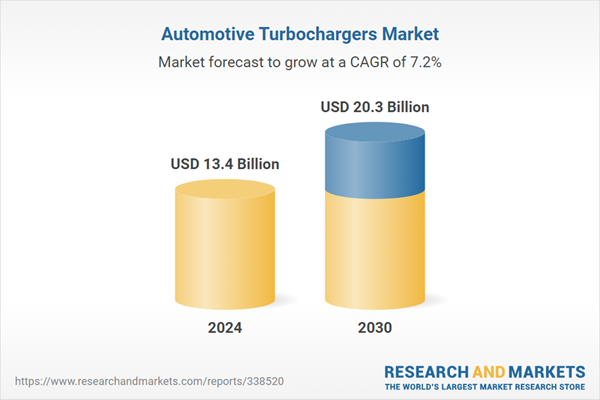The global market for Automotive Turbochargers was valued at US$13.4 Billion in 2024 and is projected to reach US$20.3 Billion by 2030, growing at a CAGR of 7.2% from 2024 to 2030. This comprehensive report provides an in-depth analysis of market trends, drivers, and forecasts, helping you make informed business decisions. The report includes the most recent global tariff developments and how they impact the Automotive Turbochargers market.
Segments: Fuel Type (Diesel, Gasoline, Other Fuel Types); Technology (Wastegate, Twin-Turbo, VNT / VGT, Electric, Double Axle, Free-Floating); End-Use (Passenger Cars, LCVs, HCVs).
Geographic Regions/Countries: World; United States; Canada; Japan; China; Europe (France; Germany; Italy; United Kingdom; Spain; Russia; and Rest of Europe); Asia-Pacific (Australia; India; South Korea; and Rest of Asia-Pacific); Latin America (Argentina; Brazil; Mexico; and Rest of Latin America); Middle East (Iran; Israel; Saudi Arabia; United Arab Emirates; and Rest of Middle East); and Africa.
The analysts continuously track trade developments worldwide, drawing insights from leading global economists and over 200 industry and policy institutions, including think tanks, trade organizations, and national economic advisory bodies. This intelligence is integrated into forecasting models to provide timely, data-driven analysis of emerging risks and opportunities.
Global Automotive Turbochargers Market - Key Trends and Drivers Summarized
What Are Automotive Turbochargers and How Do They Work?
Automotive turbochargers are a critical component in modern engine design, significantly enhancing engine efficiency and performance. A turbocharger is a device that forces more air into the combustion chamber of an engine, enabling it to burn more fuel and produce more power. This process is achieved by using a turbine driven by the engine's exhaust gases to compress the incoming air. The increased air density allows for a higher oxygen content, which improves combustion efficiency and results in a significant boost in power output. The turbocharger comprises two main sections: the turbine and the compressor, connected by a shared shaft. When exhaust gases pass through the turbine, they spin the turbine blades, which in turn drive the compressor. This compressed air is then fed into the engine’s intake manifold, providing a higher volume of air and consequently enhancing engine performance. Turbochargers are particularly valued for their ability to provide more power without a substantial increase in engine size, making them an ideal solution for manufacturers seeking to improve fuel efficiency and reduce emissions.How Are Turbochargers Transforming the Automotive Industry?
The automotive industry is undergoing a significant transformation driven by the integration of turbochargers. These devices are not only enhancing the performance of high-end sports cars but are also becoming increasingly common in everyday vehicles. This trend is largely due to stringent environmental regulations that demand lower emissions and higher fuel efficiency. Turbochargers help manufacturers meet these requirements by enabling smaller, more efficient engines to deliver the power of larger engines. For instance, a 2.0-liter turbocharged engine can provide the same performance as a naturally aspirated 3.0-liter engine, but with lower fuel consumption and reduced CO2 emissions. Furthermore, advancements in turbocharger technology, such as the development of variable geometry turbochargers (VGTs), are enabling even greater control over engine performance and efficiency. VGTs can adjust the flow of exhaust gases to the turbine, optimizing performance across a wider range of engine speeds and loads. This adaptability makes turbochargers a versatile solution for a broad spectrum of vehicles, from compact cars to heavy-duty trucks.What Are the Challenges and Innovations in Turbocharger Technology?
While turbochargers offer numerous benefits, their integration into automotive engines presents several challenges. One of the primary issues is turbo lag, the delay between the throttle input and the turbocharger's response. This lag occurs because it takes time for the exhaust gases to spool up the turbine to its optimal operating speed. Manufacturers are addressing this issue through various innovations, such as twin-scroll turbochargers, which separate the exhaust pulses from different cylinders to reduce lag and improve response times. Additionally, electric turbochargers, which use an electric motor to spool the turbine independently of exhaust gases, are being developed to virtually eliminate turbo lag. Another challenge is managing the increased heat and pressure generated by turbocharging, which can lead to engine wear and failure if not properly controlled. Innovations in materials science, such as the use of heat-resistant alloys and advanced cooling systems, are helping to mitigate these risks. Furthermore, the integration of turbochargers with hybrid and electric powertrains is opening new avenues for enhancing performance while maintaining efficiency and sustainability.What Drives the Growth in the Automotive Turbocharger Market?
The growth in the automotive turbocharger market is driven by several factors that span technological advancements, regulatory pressures, and consumer preferences. Technological innovations, including the development of variable geometry turbochargers and electric turbochargers, are propelling the market forward by offering improved performance and efficiency. Regulatory pressures aimed at reducing emissions and improving fuel economy are compelling manufacturers to adopt turbochargers as a means to comply with stringent standards. The rising popularity of downsized engines, which rely heavily on turbocharging to deliver adequate power, is expanding the market’s addressable opportunities. Additionally, the growing demand for high-performance vehicles is generating significant interest in advanced turbocharging solutions. Consumer behavior is also shifting, with buyers increasingly seeking vehicles that offer a blend of performance and efficiency, which turbocharged engines can provide. Furthermore, the trend towards electrification and hybridization in the automotive industry is creating new growth avenues, as turbochargers are being integrated into hybrid powertrains to enhance performance without compromising on fuel efficiency. Collaborations and partnerships among automakers, technology firms, and research institutions are also fostering innovation and accelerating the adoption of next-generation turbocharging technologies, ensuring sustained growth in the market.Report Scope
The report analyzes the Automotive Turbochargers market, presented in terms of units. The analysis covers the key segments and geographic regions outlined below.Segments: Fuel Type (Diesel, Gasoline, Other Fuel Types); Technology (Wastegate, Twin-Turbo, VNT / VGT, Electric, Double Axle, Free-Floating); End-Use (Passenger Cars, LCVs, HCVs).
Geographic Regions/Countries: World; United States; Canada; Japan; China; Europe (France; Germany; Italy; United Kingdom; Spain; Russia; and Rest of Europe); Asia-Pacific (Australia; India; South Korea; and Rest of Asia-Pacific); Latin America (Argentina; Brazil; Mexico; and Rest of Latin America); Middle East (Iran; Israel; Saudi Arabia; United Arab Emirates; and Rest of Middle East); and Africa.
Key Insights:
- Market Growth: Understand the significant growth trajectory of the Diesel Fuel segment, which is expected to reach US$12.3 Billion by 2030 with a CAGR of a 7.0%. The Gasoline Fuel segment is also set to grow at 7.6% CAGR over the analysis period.
- Regional Analysis: Gain insights into the U.S. market, valued at $3.5 Billion in 2024, and China, forecasted to grow at an impressive 11.5% CAGR to reach $4.7 Billion by 2030. Discover growth trends in other key regions, including Japan, Canada, Germany, and the Asia-Pacific.
Why You Should Buy This Report:
- Detailed Market Analysis: Access a thorough analysis of the Global Automotive Turbochargers Market, covering all major geographic regions and market segments.
- Competitive Insights: Get an overview of the competitive landscape, including the market presence of major players across different geographies.
- Future Trends and Drivers: Understand the key trends and drivers shaping the future of the Global Automotive Turbochargers Market.
- Actionable Insights: Benefit from actionable insights that can help you identify new revenue opportunities and make strategic business decisions.
Key Questions Answered:
- How is the Global Automotive Turbochargers Market expected to evolve by 2030?
- What are the main drivers and restraints affecting the market?
- Which market segments will grow the most over the forecast period?
- How will market shares for different regions and segments change by 2030?
- Who are the leading players in the market, and what are their prospects?
Report Features:
- Comprehensive Market Data: Independent analysis of annual sales and market forecasts in US$ Million from 2024 to 2030.
- In-Depth Regional Analysis: Detailed insights into key markets, including the U.S., China, Japan, Canada, Europe, Asia-Pacific, Latin America, Middle East, and Africa.
- Company Profiles: Coverage of players such as BorgWarner Inc., Bosch Mahle Turbo Systems GmbH & Co. KG, Continental AG, Cummins Inc., IHI Corporation and more.
- Complimentary Updates: Receive free report updates for one year to keep you informed of the latest market developments.
Some of the 17 companies featured in this Automotive Turbochargers market report include:
- BorgWarner Inc.
- Bosch Mahle Turbo Systems GmbH & Co. KG
- Continental AG
- Cummins Inc.
- IHI Corporation
- Mitsubishi Heavy Industries Ltd.
- Turbodyne Technologies Inc.
- Turbonetics Inc.
Tariff Impact Analysis: Key Insights for 2025
Global tariff negotiations across 180+ countries are reshaping supply chains, costs, and competitiveness. This report reflects the latest developments as of April 2025 and incorporates forward-looking insights into the market outlook.The analysts continuously track trade developments worldwide, drawing insights from leading global economists and over 200 industry and policy institutions, including think tanks, trade organizations, and national economic advisory bodies. This intelligence is integrated into forecasting models to provide timely, data-driven analysis of emerging risks and opportunities.
What’s Included in This Edition:
- Tariff-adjusted market forecasts by region and segment
- Analysis of cost and supply chain implications by sourcing and trade exposure
- Strategic insights into geographic shifts
Buyers receive a free July 2025 update with:
- Finalized tariff impacts and new trade agreement effects
- Updated projections reflecting global sourcing and cost shifts
- Expanded country-specific coverage across the industry
Table of Contents
I. METHODOLOGYII. EXECUTIVE SUMMARY2. FOCUS ON SELECT PLAYERSIII. MARKET ANALYSISCANADAITALYSPAINRUSSIAREST OF EUROPESOUTH KOREAREST OF ASIA-PACIFICARGENTINABRAZILMEXICOREST OF LATIN AMERICAIRANISRAELSAUDI ARABIAUNITED ARAB EMIRATESREST OF MIDDLE EASTIV. COMPETITION
1. MARKET OVERVIEW
3. MARKET TRENDS & DRIVERS
4. GLOBAL MARKET PERSPECTIVE
UNITED STATES
JAPAN
CHINA
EUROPE
FRANCE
GERMANY
UNITED KINGDOM
ASIA-PACIFIC
AUSTRALIA
INDIA
LATIN AMERICA
MIDDLE EAST
AFRICA
Companies Mentioned (Partial List)
A selection of companies mentioned in this report includes, but is not limited to:
- BorgWarner Inc.
- Bosch Mahle Turbo Systems GmbH & Co. KG
- Continental AG
- Cummins Inc.
- IHI Corporation
- Mitsubishi Heavy Industries Ltd.
- Turbodyne Technologies Inc.
- Turbonetics Inc.
Table Information
| Report Attribute | Details |
|---|---|
| No. of Pages | 183 |
| Published | April 2025 |
| Forecast Period | 2024 - 2030 |
| Estimated Market Value ( USD | $ 13.4 Billion |
| Forecasted Market Value ( USD | $ 20.3 Billion |
| Compound Annual Growth Rate | 7.2% |
| Regions Covered | Global |









